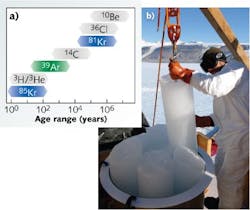Laser atom trap uses Krypton 81 to monitor ancient aquifers
Beyond carbon-14 dating, the isotopes of argon (Ar) and krypton (Kr) can be used to date samples over many orders of magnitude older. Using a laser-based technique called atom-trap trace analysis (ATTA), researchers at the U.S. Department of Energy’s Argonne National Laboratory in Illinois have applied a third-generation ATTA-3 instrument to the isolation and detection of the krypton-81 (81Kr) isotope—which has a half-life of 230,000 years—to date water samples as old as 105 or 106 years.
In the experimental setup, an all-diode-laser system at the wavelength of 811 nm is used to deliver a dozen approximately 100 mW laser beams to the atom trap. The trap captures the rare 81Kr atoms when the laser wavelength matches an excitation energy of the chosen isotope; none of the other isotopes are captured, even though their abundances are a trillion times higher. Each trapped 81Kr atom emits a continuous stream of photons that are detected by an EMCCD camera. With this development, 81Kr dating—a concept pursued in the past four decades—is now available to the earth-science community at large. For example, it has already been used to date ancient polar ice from the Taylor Glacier in Antarctica. Contact Zheng-Tian Lu at [email protected].

Gail Overton | Senior Editor (2004-2020)
Gail has more than 30 years of engineering, marketing, product management, and editorial experience in the photonics and optical communications industry. Before joining the staff at Laser Focus World in 2004, she held many product management and product marketing roles in the fiber-optics industry, most notably at Hughes (El Segundo, CA), GTE Labs (Waltham, MA), Corning (Corning, NY), Photon Kinetics (Beaverton, OR), and Newport Corporation (Irvine, CA). During her marketing career, Gail published articles in WDM Solutions and Sensors magazine and traveled internationally to conduct product and sales training. Gail received her BS degree in physics, with an emphasis in optics, from San Diego State University in San Diego, CA in May 1986.
